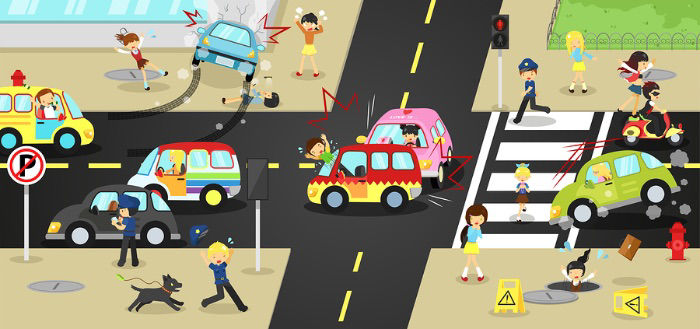NHSA Blog
Helping New Teen Drivers in the 2022-2023 School Year

The beginning of the school year means thousands of new teenage drivers will take the road for the first time. Data compiled by the Center for Disease Control and Prevention (CDC) indicates that more children are born from July-October each year, which also confirms why there are spikes in new drivers around those months as more are turning the legal age to drive.
There is also an alarming correlation to the age of teens that are injured or killed in an auto accident in their first year behind the wheel. The CDC also reports that car accidents are the leading cause of death for teens in most calendar years. Experts agree that getting the proper driver education is vital to assisting teen drivers to be safe.
Here are some details on two of our specialized online driver education courses:
One of our most popular courses is our Texas Parent Taught Drivers Ed + Permit Test. This state-approved course goes far beyond the minimum curriculum requirements. First-time drivers under the age of 18 are required to complete a 32-hour driver education course to apply for a Texas Learner Permit and Driver License. Our course can be taken 100% online and you can take the permit test as part of the course without needing to go to the DPS. The Parent Taught Course is an excellent setting to create open communication and a relaxed setting for parents to impart valuable driver insights provided in the course. There is also an option to upgrade the course to include an additional 4 courses to be taken during the first year of driving to further imbed safe driving practices.
Another popular course is our Florida Combo Course which includes the state-required Traffic Law Course as well as the Substance Abuse Education Course. Through dynamic quizzes, interactive learning modules, and videos, these courses are sure to educate and prepare teenage drivers to be safe behind the wheel and to be aware of the most common challenges and difficulties for new drivers.
At NHSA, our goal is to provide online driver education courses that equip all drivers with what they need to be safe drivers. Whether you are a teen seeking a learner’s permit, or an adult driver seeking a basic driver safety course, check us out online to see what courses are available in your state!

NHSA Partners with SADD
National Highway Safety Administration, (NHSA), is proud to announce its partnership with Students Against Destructive Decisions, (SADD). For over 40 years SADD has been a champion of empowering and mobilizing students and adult allies to engage in positive change through leadership and smart decision-making. SADD develops and shares prevention programming to engage students in the pursuit of healthy decision-making.
At NHSA, our goal is to give our students a solid foundation of driving knowledge and skills that assist them to be safe drivers. Through the use of videos, animations, dynamic quizzes, interactive games, and storytelling, we help students remain engaged in our courses as they become safe, responsible, and confident drivers.
We believe our partnership with SADD will help both of our organizations to better prepare today’s youth for a safe and successful future. Check us out to see what courses are available in your state!
How to Face Peer Pressure as a Teen Driver

Peer pressure can be one of the most powerful influential forces in a teen’s life. Studies have shown that teens face both positive and negative peer pressure constantly, so having a plan of action in place will help teens respond in a way that protects them from destructive decisions.
Preparing a teen to face peer pressure starts with the environment at home. Parents who give appropriate praise and encouragement to their children help to build their child’s self-esteem and confidence. These are essential qualities needed to face peer pressure. When children feel comfortable expressing themselves to their parents, they are more likely to seek support in dealing with challenging situations at school with their peers rather than internalizing those difficult thoughts and feelings.
Why is choosing the right friends so important? Negative peer pressure can isolate a youth into thinking that, unless they conform to those applying the peer pressure, they will never be liked or accepted. Having a core group of genuine friends will help a teen to already feel accepted and less likely to be concerned about the opinions of those applying the pressure.
Peer pressure to drink. Teens are exposed to many vices at school. Even if they never drink underage, it is common to be aware of peers who do. Having a go-to plan of how to face pressure to drink is vital for a teen, especially one who is new to driving. The easiest plan to combat peer pressure to drink or take drugs is to blame your parents. Expressing to those applying pressure what punishment or loss of privileges you will face from your parents can help to avoid peer pressure from influencing your behavior. Next, remove yourself from the situation. Why stay around a bully and submit yourself to more pressure?
Sadly, underage drinking and driving bring heavy consequences every year. Be prepared for what you may face. Talk to your parents. Bond with friends who have good values that will support you. Have a plan of what to say to those pressuring you. Remove yourself from an unsafe situation. These steps can save lives.
At NHSA, our goal is to provide online driver education courses that equip all drivers with what they need to be safe drivers. Whether you are a teen seeking a learner’s permit, or an adult driver seeking a basic driver safety course, check us out online to see what courses are available in your state!

Earn More With NHSA's Affiliate Referral Program
NHSA is excited to announce our new affiliate referral program that will pay you for a job you are already doing! Let us explain how it works!
Insurance Brokers: We know that servicing your clients’ needs involves seeking to get them the best rate for their auto insurance. Referring your customers to NHSA for an online driver safety course to remove points from their license, or a driver education course for new drivers can help to show them you truly are seeking their best interests and are doing all you can to keep their insurance premiums as reasonable as possible!
Driving Instructors: Many in-person driving schools want students to already have their learner’s permit and do not offer such classes themselves. Other schools may provide driver training but are not associated with insurance discount programs or traffic law programs to help them AFTER students have obtained their driver’s license. Having a system in place to refer all students to NHSA can help them with their future needs.
Home School Curriculum Companies: More and more families are making the decision to educate their children from home. Very few of these companies have online driver education courses available or even an affiliation with a driving school. Let NHSA partner with you to provide online driver education for teens already enrolled in your courses.
How You Get Paid: When you register as an affiliate with NHSA we will pay you a percentage of your client’s course fee. They win! You win! Reach out to us at info@usnhsa.com to get set up and start earning today!
Headrest Positioning—Why it Matters

The NHSTA reports that whiplash is a common result from rear-end collisions. A few simple steps can help lower your risk of injury.
Position your seat appropriately.
Your seat should be positioned at an angle of less than 20 degrees. Sitting in this position will help your body to stay seated in the event of a rear-end collision.
Check the height of your head restraint.
The top of your head restraint should not be lower than the top of your head. You can check this by using your hand to make sure that your head and the restraint are at the correct heights.
Make sure your head restraint is close enough.
The proper position for your restraint is about 2 inches from the back of your head. The closer your head restraint is to your head, the less distance your head will travel, thus causing less injury in the event of a rear-end collision.
At NHSA, our goal is to provide online driver education courses that equip all drivers with what they need to be safe drivers. Whether you are a teen seeking a learner’s permit, or an adult driver seeking a basic driver safety course, check us out online to see what courses are available in your state!
How to be Proactive in Reducing Teen Driver Accidents

Teens aged 16-19 have the highest risk of being involved in a motor vehicle accident. This age group is also several times more likely to be in a fatal crash than any other age group. Identifying and addressing key risk factors will help parents ensure their teens are fully prepared to be safe drivers.
Inexperience: Defensive driving involves identifying potential dangers and making critical decision to navigate through them safely. Newer drivers are more likely to underestimate risks. As you drive with your teen, periodically vocalize your thoughts and explain your decisions so they can better understand how to scan for risks and take appropriate action when needed.
Not using seat belts: Seat belts save lives. However, teens use safety belts less than any other age group. Setting a good example by buckling up in front of your children will help to instill good habits in them. Kind reminders go a long way as well!
Distracted driving: Being distracted, even for a moment, while driving can have enormous repercussions. Make sure that your teen sets cellular devices to a safe mode while driving and limits the number of additional teen passengers. These habits help to reduce the risk of distraction significantly.
Impaired driving: Any impairment while driving will slow reaction time in both identifying and reacting to a situation. Help your teen to appreciate how quickly a situation can develop while driving. Any alcohol or substance in their system can impair them considerably. Have an honest discussion of what to do if they or their friends are not in a safe condition to drive.
This is not an exhaustive list of all risks teen drivers will face. However, like all risks we may face, taking time to discuss them and to prepare a plan of action will help to prevent getting caught off guard. At NHSA, our goal is to prepare individuals to be safe and successful drivers. We offer a free practice test for a driving permit in all 50 states. We also offer online driver education courses for those seeking their driver’s license as well as an array of defensive driving and basic driver safety courses. Visit us to see what driver courses are available in your state!
7 Important Things to Document When in a Collision
.jpeg)
Getting into an accident is one of the most unnerving and stressful situations you can experience. It can be difficult to remain calm and properly handle the situation when under duress. Having a plan to document what happened at a collision using your cell phone can help navigate a challenging situation in the best way you can. After alerting the authorities and confirming the safety of all involved, take video and pictures to document the following 7 points:
- Show the crash scene from multiple angles.
- Take both wide shots and close-ups.
- Indicate the direction in which the vehicles were traveling.
- Try to capture the visibility, weather conditions, and traffic density.
- Capture any visible damage to each of the vehicles involved.
- Take pictures of the driver’s license of each driver involved.
- Take pictures of the insurance and registration of each driver involved.
Do Not
- Take pictures of any injuries in the accident.
- Put yourself in harm’s way, such as walking out into moving traffic.
- Get in the way of first responders.
At NHSA, our goal is to prepare individuals to be safe and successful drivers. We offer a free practice test for a driving permit in all 50 states. We also offer online driver education courses for those seeking their driver’s license as well as an array of defensive driving and basic driver safety courses. Visit us to see what driver courses are available in your state!
Driving Safely at Railroad Crossings

According to recent data compiled by the Federal Railroad Administration (FRA), in 2013 there were 2,087 vehicle-train collisions in the United States, resulting in 251 deaths and 929 injuries. Similar data from 2011 reported 2,059 collisions with 250 fatalities and 1,041 injuries.
Being aware of your surroundings and following a few basic rules will help you get across a railroad crossing safely.
1. Slow down when approaching a railroad crossing. Look for warning lights or a lowered gate. Even if the lights are not flashing, and the gate is not lowered, look both ways and listen to make sure no train is coming before you attempt to cross the tracks.
2. As you get near the crossing, roll down your windows to hear more clearly whether a train is approaching.
3. Stop no closer than 15 feet from a railroad crossing if a train is approaching.
4. Only cross the tracks at designated areas.
5. When there are multiple tracks and a train has already passed, check in both directions to make sure that no other trains are coming on additional tracks before attempting to cross.
6. Carefully read any posted signs and follow the instructions provided.
Even if you cross the same set of tracks each day, never assume that the tracks will be clear. A quick glance in each direction can be a lifesaver! Following these simple reminders will provide an extra layer of safety and help you to arrive safely.
At NHSA, our goal is to provide online driver education courses that equip all drivers to be safe drivers. Whether you are a teen seeking a learner’s permit, or an adult driver seeking a basic driver safety course, check us out online to see what courses are available in your state!
Understanding Who Has the Right-of-Way

Safe drivers understand that driver safety involves being aware of their surroundings at all times. Understanding the “rules of the road”, including a keen awareness of who has the right-of-way in all situations, will improve safety and reduce the risk of an incident. Take note of who has the right-of-way in the following scenarios.
1. At stop signs
If you are at a stop sign you should come to a complete stop and then allow other cars, pedestrians, and cyclists to go. The first driver to stop at a 4-way stop should be the first to proceed. If you happen to arrive at the same time as another car then the car on the right should go first.
2. Intersections with no traffic signs or signals
When entering this type of intersection, you should yield to vehicles that are already in the intersection. Before turning left, you should yield to any vehicle that is coming from the opposite direction.
3. Driveways, alleys, and roadsides
If you are entering or exiting any of these you need to yield the right-of-way to any vehicle, cyclist, or pedestrian that is using the road or sidewalk.
4. Yielding to emergency vehicles
The law requires drivers to yield to any authorized emergency vehicle. If the driver is unable to move over or is on a single-lane road they must slow down to allow the emergency vehicle to pass.
5. Yielding to pedestrians
You must always allow pedestrians to have the right-of-way, especially if they are in an intersection. Be particularly alert to those who may be blind. It is often possible to identify blind pedestrians by their use of a guide dog or a white cane.
While these examples are not all-inclusive, they can help you to understand what right-of-way involves and how yielding to others on the road can save lives. Stay alert! To lessen the risk of a collision, you should never assume that other drivers would show courtesy or follow the above guidelines.
At NHSA, our goal is to provide the highest quality online driver education training for teens and adults. Log on and see what courses are available in your state!
Reasons Why You Are More Likely to Get Into an Accident Close to Home

Data collected by the NHTSA, (National Highway Transportation Safety Board) continues to show that most accidents take place within a few miles of each driver's home. Understanding the reasons why can assist drivers to take proactive steps to reduce these risks and get home safely.
One logical reason that accidents take place close to home is that most of our driving is done near our home. The grocery store, school drop-offs, doctor’s appointments, and so forth are usually selected in part by their proximity to our residence.
Since we are most familiar with areas near our home it is possible to let our guard down. Don't drop your guard due to street familiarity and overconfidence. Remaining vigilant at all times while driving is essential in reducing driving risks.
Another common factor in vehicular accidents is driver fatigue. A study done by the Center for Disease Control and Prevention (CDC) stated that 37% of adults get less sleep than they should. This is a fact that speaks volumes of the potential for driving while tired. A tired driver can have increased risks similar to one who has been drinking. If you are exhausted on your way home from work, or perhaps from a long drive, you can easily miss identifying certain risks in time. Getting sufficient rest along with a healthful diet, or even allowing a more rested passenger to drive, will help to get home safely.
At NHSA, we are committed to helping all drivers to be safe drivers. Our online driver’s education classes and basic driver safety courses will help you to be fully prepared for driving safely. See what driving classes are available in your state!

